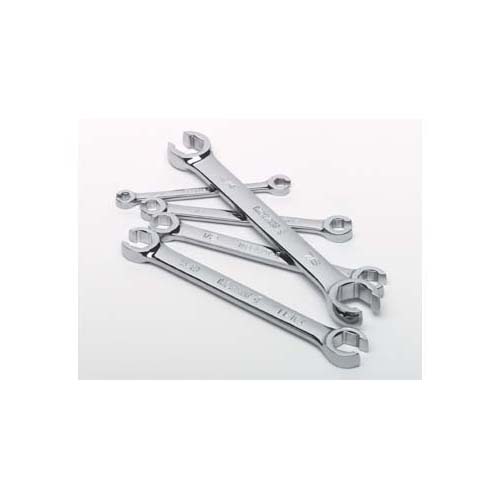 I usually advise people to buy cheaper tools if they are just a shade tree mechanic, but in this case, buy the best. Cheap line wrenches do not work, and will bend or round off the fitting before cracking it loose. Buy a snap-on, MAC or Craftsman set and good luck.
Kevin
P.S. Remember to use plenty of penetrating lubricant on the fittings before you try to remove the fitting. I use PB Blaster, or Kroil.
I usually advise people to buy cheaper tools if they are just a shade tree mechanic, but in this case, buy the best. Cheap line wrenches do not work, and will bend or round off the fitting before cracking it loose. Buy a snap-on, MAC or Craftsman set and good luck.
Kevin
P.S. Remember to use plenty of penetrating lubricant on the fittings before you try to remove the fitting. I use PB Blaster, or Kroil. Monthly Archives: February 2006
-
Give me a Brake !
Posted on February 23, 2006 by kevin
The worst thing when working on your brakes, is not having the right tool. When changing brake lines or hoses, the proper wrench will save you a ton of time and frustration. Special line wrenches are designed to put the most amount of force to the fitting without slipping off. Anyone who has tried to remove a rusty brake line with a regular wrench knows that the wrench slips off way too easy and rounds off the fitting. Here is a picture of a line wrench... I usually advise people to buy cheaper tools if they are just a shade tree mechanic, but in this case, buy the best. Cheap line wrenches do not work, and will bend or round off the fitting before cracking it loose. Buy a snap-on, MAC or Craftsman set and good luck.
Kevin
P.S. Remember to use plenty of penetrating lubricant on the fittings before you try to remove the fitting. I use PB Blaster, or Kroil.
I usually advise people to buy cheaper tools if they are just a shade tree mechanic, but in this case, buy the best. Cheap line wrenches do not work, and will bend or round off the fitting before cracking it loose. Buy a snap-on, MAC or Craftsman set and good luck.
Kevin
P.S. Remember to use plenty of penetrating lubricant on the fittings before you try to remove the fitting. I use PB Blaster, or Kroil.
This post was posted in DIY Tools
-
How to check your clutch...
Posted on February 6, 2006 by kevin
I use this trick when checking out a used car. Since you can not climb under a car and check how much material is left on the clutch disc, you can only guess the condition. Using the following tips you can get closer to an educated guess and hopefully make a good decision. 1. Operate the clutch and observe where the clutch grabs. It should grab about 2" from the floor. The motion of the pedal should be smooth and even. Make sure you have the emergency brake on when doing any of these tests. 2. Listen for any chatter or squealing when operating the clutch. Is there a grinding noise when the clutch is depressed? This indicates a worn throwout bearing, and will require the transmission to be removed to replace it. You can assume if the throwout bearing is bad, the clutch is not in the best condition. 3. Put the car in 2nd or third gear and let the clutch out slowly. (make sure the car's emergency brake is on, and you have your foot on the brake) Does the engine RPM decrease and almost stall? If it does, the clutch still has some life in it, and is doing it's job. If the clutch slips, and the engine does not sound like it's going to stall, there is a good chance the clutch needs to be replaced. 4. While on a road test, does the transmission shift smoothly? Is there any crunching when changing gears? A crunching noise when shifting usually indicated bad sychnonizers in the transmission, but can sometime just be the clutch cable being out of adjustment. Keep these tips in mind the next time you are inspecting a used car, or trying to diagnose your own car. A manual transmission car can be a blast to drive, and offer better fuel economy, but presents unique issues when trying to evaluate it's health. More information on your Car's driveline Kevin
This post was posted in Drivetrain
2 Item(s)


